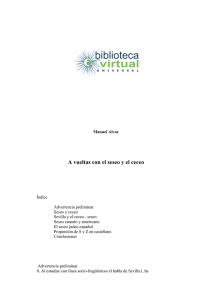Ceseo Seseo Yeismo y Otros
Anuncio
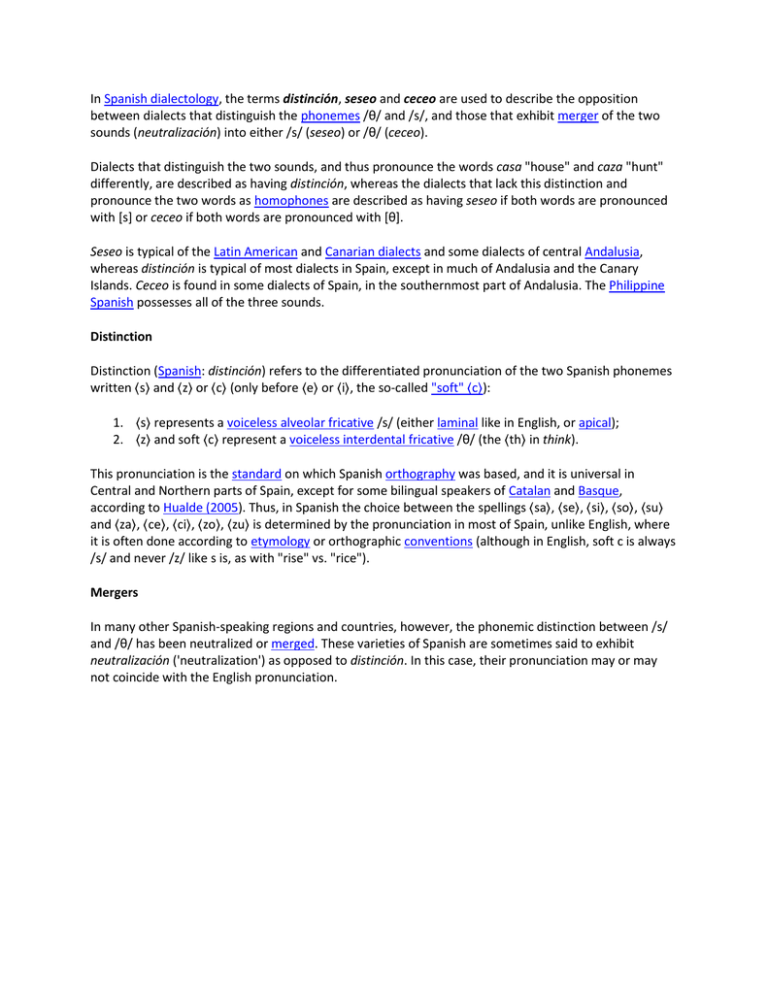
In Spanish dialectology, the terms distinción, seseo and ceceo are used to describe the opposition
between dialects that distinguish the phonemes /θ/ and /s/, and those that exhibit merger of the two
sounds (neutralización) into either /s/ (seseo) or /θ/ (ceceo).
Dialects that distinguish the two sounds, and thus pronounce the words casa "house" and caza "hunt"
differently, are described as having distinción, whereas the dialects that lack this distinction and
pronounce the two words as homophones are described as having seseo if both words are pronounced
with [s] or ceceo if both words are pronounced with [θ].
Seseo is typical of the Latin American and Canarian dialects and some dialects of central Andalusia,
whereas distinción is typical of most dialects in Spain, except in much of Andalusia and the Canary
Islands. Ceceo is found in some dialects of Spain, in the southernmost part of Andalusia. The Philippine
Spanish possesses all of the three sounds.
Distinction
Distinction (Spanish: distinción) refers to the differentiated pronunciation of the two Spanish phonemes
written ⟨s⟩ and ⟨z⟩ or ⟨c⟩ (only before ⟨e⟩ or ⟨i⟩, the so-called "soft" ⟨c⟩):
1. ⟨s⟩ represents a voiceless alveolar fricative /s/ (either laminal like in English, or apical);
2. ⟨z⟩ and soft ⟨c⟩ represent a voiceless interdental fricative /θ/ (the ⟨th⟩ in think).
This pronunciation is the standard on which Spanish orthography was based, and it is universal in
Central and Northern parts of Spain, except for some bilingual speakers of Catalan and Basque,
according to Hualde (2005). Thus, in Spanish the choice between the spellings ⟨sa⟩, ⟨se⟩, ⟨si⟩, ⟨so⟩, ⟨su⟩
and ⟨za⟩, ⟨ce⟩, ⟨ci⟩, ⟨zo⟩, ⟨zu⟩ is determined by the pronunciation in most of Spain, unlike English, where
it is often done according to etymology or orthographic conventions (although in English, soft c is always
/s/ and never /z/ like s is, as with "rise" vs. "rice").
Mergers
In many other Spanish-speaking regions and countries, however, the phonemic distinction between /s/
and /θ/ has been neutralized or merged. These varieties of Spanish are sometimes said to exhibit
neutralización ('neutralization') as opposed to distinción. In this case, their pronunciation may or may
not coincide with the English pronunciation.
Ceceo
Map of Andalusia.
ceceo
seseo
distinction
Ceceo is a phenomenon found in a few dialects of southern Spain in which the historical phonemes /s/
and /θ/ are both realized as [θ]. In other words, only the latter sound is used for ⟨s⟩, ⟨z⟩, and soft ⟨c⟩.
Ceceo is found primarily in some varieties of Andalusian Spanish, although Hualde reports that there is
some evidence of it in parts of Central America. In a number of Spanish speakers in the Philippines,
ceceo can also be observed, being coexistent with distinción and seseo. It is a largely rural pronunciation
and is often stigmatized.[1] Note that although these dialects make no distinction between the letters ⟨s⟩
and ⟨c⟩/⟨z⟩, they are never pronounced as in English in this case.
Seseo
Seseo is the merger in the opposite direction: the original phonemes /s/ and /θ/ are both pronounced as
[s]. Seseo is the most widespread pronunciation among Spanish speakers worldwide. Although a
minority pronunciation in Spain, virtually all speakers in Hispanic America are seseantes, and seseo is
considered standard in all varieties of Latin American Spanish. This also applies to most of the Spanish
speakers in the Philippines, the lone representative of the Hispanic World in Asia. It does coexist with
distinción and ceceo in parts of Spain (e.g. in Canary Islands and in some areas of Andalusia), and again
in the Philippines. Traditional dialect atlases (e.g., Alvar (1991)) show one variant or another used in
adjacent regions. In Spain, seseo is considered "more socially acceptable or perhaps 'less substandard'
than ceceo."[2]
The following table gives an example of the three pronunciation patterns discussed so far:
la casa "the house" la caza "the hunt"
distinción
/la ˈkasa/
/la ˈkaθa/
ceceo
/la ˈkaθa/
/la ˈkaθa/
seseo
/la ˈkasa/
/la ˈkasa/
Ceseo or seceo
Many speakers of ceceo and seseo dialects in Spain show sociolinguistic variation in usage. In some
cases, this variation may arise when a ceceo or seseo speaker more or less consciously attempts to use
distinción in response to sociolinguistic pressure (hypercorrection). However, as, for instance, in the case
of the variation between the standard velar nasal and alveolar pronunciation of the nasal in -ing in
English (walking versus walkin'), the switching may be entirely unconscious. It is perhaps evidence of the
saliency of three-way ceceo-seseo-distinción variation that inconsistent use has elicited evaluative
comments by some traditional Spanish dialectologists. For instance, Dalbor (1980) discussed it as
"sporadic or chaotic switching [between /s/ and /θ/] and the use of intermediate sounds impossible to
determine with precision".[3] Obaid (1973) proposes the synonymous terms ceseo and seceo to refer to
these "mixed" patterns, and notes surprise at a speaker who produced all four possible pronunciations
of Zaragoza within the space of a few minutes.[4] In fact, sociolinguistic variation is typically highly
structured in terms of how often each variant will appear given various social and linguistic independent
variables.
Origins
Map showing the presence or absence of /θ/ in the Iberian Peninsula. Areas in light green are either
seseo zones for Spanish and Galician or areas where other languages, not having the [s] / [θ] contrast,
are spoken
Castilian lisp
A persistent urban legend claims that the prevalence of the sound /θ/ in Spanish can be traced back to a
Spanish king who spoke with a lisp, and whose pronunciation spread by prestige borrowing to the rest of
the population. This myth has been discredited by scholars for lack of evidence.[5] Lundeberg (1947)
traces the origins of the legend back to a chronicle of López de Ayala stating that Pedro of Castile "lisped
a little" ("ceceaba un poco"). The timeline is totally incorrect, however: Pedro reigned in the 14th
century, but the sound /θ/ only began to develop in the 16th century (see below). Moreover, it is clear
that a true lisp would not give rise to the systematic distinction between /s/ and /θ/ that characterizes
Standard Peninsular pronunciation. For example, a lisp would lead one to pronounce both siento "I feel"
and ciento "hundred" the same (as [θjento]), whereas in Standard Peninsular Spanish they are
pronounced [sjento] and [θjento], respectively.
Nevertheless, for speakers of seseo varieties of Spanish, where /θ/ is absent, and for people who are
more familiar with seseo pronunciation (e.g., learners of Spanish in North America), the use of /θ/ by
Peninsular speakers is striking, and does indeed give an impression of "lispiness". The misnomer
"Castilian lisp" is used occasionally to refer to this aspect of Peninsular pronunciation (in both distinción
and ceceo varieties).
Historical evolution
In the 15th century Spanish had developed eight sibilant phonemes,[6] more than any current variety of
Spanish. Those eight phonemes merged differently as they evolved during the 16th and early 17th
centuries into the pronunciation of the modern dialects.[7] There were four pairs of voiceless versus
voiced sibilants: dental/alveolar affricates
s/ vs.
z/ (spelled ⟨c⟩/⟨ç⟩ vs. ⟨z⟩); dental/alveolar
fricatives /s/ (spelled ⟨ss⟩ when intervocalic, ⟨s⟩ otherwise) vs. /z/ (intervocalic only, spelled ⟨s⟩);
postalveolar affricates
ʃ/ vs.
ʒ/; and postalveolar fricatives /ʃ/ vs. /ʒ/ (⟨x⟩ vs. ⟨j⟩ and ⟨g⟩ before
⟨i⟩/⟨e⟩). Most likely, /dʒ/ deaffricated and merged with /ʒ/ before the year 1500.[8] The main difference
between the prestige dialect of North Central Spain and dialects to the south (such as Andalusian
Spanish) was that, in the north, dental/alveolar continuants were more retracted than the affricates (the
former pair can be represented as
/ and
/ and the latter as
/ and
/) but homorganic
[9]
in those to the south such as in Andalusia.
The first step away from that system was the deaffrication of
/ a couple of decades after 1500.
Because of a differing place of articulation, this still contrasted with
/ in the prestige dialect of North
Central Spain, though it was a complete merger for southern dialects.[10]
pronunciation
orthography
⟨j⟩ or soft ⟨g⟩
voiced
/dʒ/ → /ʒ/
voiced
/→
/
⟨z⟩
voiceless
ʃ/
⟨ch⟩
voiced affricates →
fricatives
voiceless affricates
voiceless
/
⟨c⟩ (before ⟨e⟩, ⟨i⟩) or ⟨ç⟩ (before ⟨a⟩, ⟨o⟩,
⟨u⟩)
voiced
/
intervocalic ⟨s⟩
voiceless
/
⟨s⟩ (syllable-initial or -final) or ⟨ss⟩
(intervocalic)
apicoalveolar fricatives
postalveolar fricatives
voiced
/ʒ/
⟨j⟩ or ⟨g⟩ (before ⟨e⟩, ⟨i⟩)
voiceless
⟨x⟩
/ʃ/
The second step was the devoicing of voiced sibilants.[10] In the north,
/ and /ʒ/ were lost, though
/ remained contrastive as there had been no voiceless
/. This sound contrasted with two
acoustically similar sounds: dentoalveolar
/ and apicoalveolar
/. By 1600,
/ had
deaffricated and merged with
/.[10] Subsequent changes to the sound system of Spanish retained the
contrasts while enhancing the segments by increasing articulatory distance amongst their rather subtle
acoustic contrasts, an appropriate step due to the high productivity of these phonemes in differentiating
frequently used minimal pairs. The dentoalveolar one was moved "forward" to interdental
/, losing
its former sibilance in the process (which increased its acoustic distance to the remaining sibilant ⟨s⟩),
and the prepalatal one was moved "backward" to velar /x/ also losing its former sibilance. All in all
resulting in the three-way distinction found in modern Standard Peninsular pronunciation:
original 6-way
contrast
/–
deaffrication
1
/
devoicing
/–
/
/–
deaffrication
2
/–
/
/
modern
distinción
/
/
/ʒ/ – /ʃ/
/ʃ/
orthography
]
⟨z⟩ or ⟨c⟩ (before
⟨e⟩, ⟨i⟩)
]
⟨s⟩
⟨j⟩ or ⟨g⟩ (before
⟨e⟩, ⟨i⟩)
[x]
In the south, the devoicing process and deaffrication of
s/ gave rise to new fricatives that were
indistinguishable from the existing ones. The process of increasing articulatory distance still applied,
however, and /ʃ/ retracted to /x/ in the south just as it did in the north.[7] In a number of ceceo areas
(particularly the southernmost provinces like Cádiz) /s/ developed into a non-sibilant apico-dental
],
perceptually similar to the interdental
/ used by Standard Peninsular speakers for orthographic
⟨c⟩/⟨z⟩. In seseo areas (particularly in the westernmost provinces like Seville and Huelva), the resulting
phoneme developed a predorsal alveolar realization
] (like English ⟨s⟩), perceptually similar to the
apicoalveolar
] used by Standard Peninsular speakers for orthographic ⟨s⟩. This seseo variety was the
pronunciation that most impacted Latin America, as many emigrants to the Americas were from
Andalusian and Canarian ports. In addition, several generations of Spanish speakers had lived and grown
in the Americas before /θ/ appeared in Castilian.[11]
original 6-way deaffrication
deaffrication modern modern
devoicing
contrast
1
2
ceceo
seseo
z/ –
s/
/z/ – /ts/
/s/ – /ts/
/s/
]
]
orthography
⟨z⟩, ⟨c⟩, ⟨s⟩
/z/ – /s/
/ʒ/ – /ʃ/
/ʃ/
[x]
[x]
⟨j⟩ or ⟨g⟩ (before ⟨e⟩, ⟨i⟩)
The development of the sibilants in Ladino (which split off from Castilian and other Peninsular varieties
in the 15th century) was more conservative, resulting in a system closer to that of Portuguese.[
DIFERENTES APROXIMACIONES AL SESEO Y CECEO
Ceceo y seseo, fenómenos fonéticos que se producen en determinadas zonas donde se habla español y
consisten en una pronunciación alterada de la z y la c (de cecina) con la s.
Existe seseo cuando se pronuncia s en lugar de z. En esos casos se conserva la ortografía del fonema, es
decir, z ante a, o, u, y c ante e, i, pero no se emite en la lengua hablada. Junto a ello existe una alteración
en la emisión de la s, que deja de ser ápico-alveolar para pasar a ser predorsal. Dada la extensión de la
pronunciación seseante, ha dejado de ser considerada como errónea o dialectal, ya que sería más
sencillo marcar las zonas no seseantes del dominio lingüístico hispano y que corresponderían a las dos
Castillas, Madrid, algunas zonas catalano-hablantes, Asturias, Cantabria y el País Vasco. En el resto de los
países y comunidades donde se habla español, incluidas las de América Latina, existe el seseo.
El ceceo consiste en pronunciar la z por la s. En este caso varía la pronunciación de la z, que no es
interdental, sino que la punta de la lengua se apoya sobre los incisivos inferiores. Este fenómeno está
poco extendido y no se considera un fenómeno correcto. Pertenece a algunas zonas de la Extremadura
meridional y a la Andalucía rural. Es también un rasgo de la lengua hablada pero no escrita. Los
hermanos Álvarez Quintero utilizan ambos fenómenos en sus obras de teatro costumbristas andaluzas
para caracterizar a sus personajes.
Seseo, ceceo, yeísmo, voseo y otros
I. Introducción
En la lengua castellana se producen unos determinados fenómenos que afectan principalmente a la
pronunciación. Casi todos se relacionan con una determinada área geográfica del vasto campo por el
que se extiende nuestra lengua, en conexión con los dialectos; algunos son admitidos, otros tienen que
ver con expresiones vulgares y con el mal uso de la lengua y que, por tanto, deben ser desterrados. Son
los siguientes.
II. El seseo
Es una confusión entre las consonantes c - z y la consonante s, en el habla: ce, ci y za, zo, zu se
pronuncian como se, si y sa, so, su. Se sustituye el fonema /Ø/ por el fonema /s/. Afecta sólo a la
pronunciación, no a la escritura.
Ejemplos: taza se pronuncia tasa, cena - sena, cielo - sielo, zumo - sumo, lazo - laso. Dicha pronunciación
está admitida socialmente y no se considera defectuosa.
Este fenómeno se inicia en los siglos XV y XVI en Sevilla y su comarca, de allí se extiende a otras zonas no todas - de Andalucía, Canarias, Hispanoamérica y pequeños núcleos de Badajoz, Murcia y Alicante.
Existe también el seseo en Cataluña, Valencia, Galicia y Vascongadas, según los estudiosos; su uso aquí
es considerado socialmente como defectuoso. En todas estas zonas conviven hablantes de seseo,
hablantes de ceceo y hablantes que distinguen entre las consonantes c - z y la consonante s.
A veces, los escritores incluyen en sus obras textos con seseo, casi siempre para caracterizar personajes.
Juan Ramón Jiménez dice de Platero "Tien'asero" (tiene acero).
III. El ceceo
Es una confusión entre la consonante s y las consonantes c - z, en el habla: se, si y sa, so, su se
pronuncian como ce, ci y za, zo, zu. Se sustituye el fonema /s/ por el fonema /Ø/. Afecta sólo a la
pronunciación, no a la escritura. Como vemos, es lo contrario del seseo.
Ejemplos: serio se pronuncia cerio, simpático - cimpático, rosa - roza, beso - bezo, suspiro - zuzpiro. Es
una pronunciación menos admitida socialmente que el seseo.
Se inicia, como el seseo, en los siglos XV y XVI en Sevilla y su comarca, de allí se extiende, de forma
mucho menos intensa, a otras zonas - no todas - de Andalucía, Canarias, Hispanoamérica y pequeños
núcleos de Cáceres.
A veces, los escritores incluyen en sus obras textos con ceceo, casi siempre para caracterizar personajes,
como en los sainetes de Carlos Arniches.
IV. El yeísmo
Confusión de la consonante ll con la y en el habla: lla, lle, lli, llo, llu se pronuncian como ya, ye, yi, yo, yu.
Es un fenómeno admitido en la pronunciación; en la escritura es una incorrección. Se puede decir caye
en vez de calle, siya por silla, gayina por gallina, yuvia por lluvia, pero no se pude escribir caye, siya, etc.
Esta confusión entre de ll - y produce otra grave incorrección: escribir ll en vez de y: se debe cuidar no
escribir mallo por mayo, pallaso por payaso, sullo por suyo.
El yeísmo se inicia en la Edad Media y se afirma en el s. XVI. La causa es la mayor facilidad de
pronunciación de la y que de la ll. La zona de yeísmo más intensa se sitúa en Madrid y hacia el sur;
abunda en Hispanoamérica, en Canarias y en el judeoespañol (llamado también judeo-sefardí). El yeísmo
ha estado muchas veces asociado al habla de la ciudad frente al habla rural. Hoy es un fenómeno en
alza, sobre todo entre los jóvenes, debido a su uso continuo en radio y televisión.
V. Voseo
Es la utilización de vos por tú. Se usa para dirigirse a una persona con la que se tiene confianza o
igualdad. Para situaciones de respeto se usa usted. El voseo solamente se emplea en la segunda persona
del singular. En plural se usa ustedes, nunca vosotros. El voseo modifica el verbo: se usan plurales de
segunda persona cantás, tenés, e imperativos andá, vení.
Se utilizó en España hacia 1500, pero desapareció. Es una característica del habla de algunos países de
Hispanoamérica: Argentina, Uruguay, Paraguay y América Central. Alternan el vos y el tú en Panamá,
Colombia, Venezuela, Ecuador, Chile. En el resto se utiliza tú: Méjico, Perú, Las Antillas, etc. Los
escritores hispanoamericanos lo utilizan en sus obras, baste el "Vos creés que estás en esta pieza pero
no estás", de Julio Cortázar en "Rayuela".
VI. Otros
Aspiración de consonantes
Dicha modalidad es común a varias lenguas romances: griego, inglés, alemán, francés. En el idioma
castellano podemos encontrar las siguientes modalidades (la h se pronuncia como una especie de j):
1.
h procedente de f inicial latina: jambre por hambre, jartar por hartar
2.
s implosiva: loj piej por los pies, loj dientej por los dientes.
A veces dicha aspiración produce la desaparición de la s: lo piej (los pies) o la reduplicación de la
consonante siguiente: lop piej (los pies)
Confusión de vocales
1.
utilización de la e por la i: ceviles por civiles
2.
utilización de la e por la o: menumento por monumento
3.
utilización de la e por la a: merendemos por merendamos
4.
utilización de la i por la e: acordión por acordeón, cai por cae, sigún por según
5.
utilización de la o por la u: sepoltura por sepultura
6.
utilización de la u por la o: tualla por toalla
Confusión de consonantes
1.
utilización de la l por la r : albol por árbol, arma por alma
2.
utilización de la k por la c: kuento por cuento
3.
utilización de la z por la d: azvertir por advertir
4.
utilización de la t por la d: verdat por verdad
5.
confusión entre h, g, b: güevo y buevo por huevo; güeso y bueso por hueso
6.
simplificación: asfisia por asfixia, istancia por instancia
7.
exageración en la pronunciación: aspezto por aspecto, acsurdo por absurdo
8.
deformaciones: alvertir por advertir
9.
desaparición de la d: diputao por diputado, dormío por dormido, colorá por colorada, na por
nada, Madrí por Madrid
10.
desaparición de la g: auja por aguja
11.
desaparición de la r: señá por señora
12.
desaparición de la preposición de: Plaza Colón por Plaza de Colón. Pero no desaparece en Paseo
del Prado
13.
adición de s en la segunda persona del pretérito perfecto simple: leístes por leíste
14.
anteposición de me y te a se: me se olvidó o te se olvidó por se me olvidó o se te olvidó
15.
anteposición del pronombre al imperativo: me dé un libro por deme un libro
16.
dequeísmo: utilización abusiva de de que: le dije de que viniera por le dije que viniera, de que oí
la canción por en cuanto oí la canción
17.
acentuación del determinante posesivo antepuesto al nombre: mí libro, tú disco, sú blusa por mi
libro, tu disco, su blusa
18.
acortamiento de palabras: cole, poli por colegio, policía
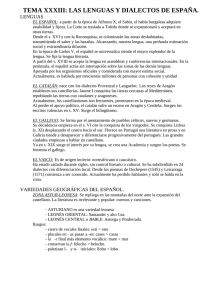
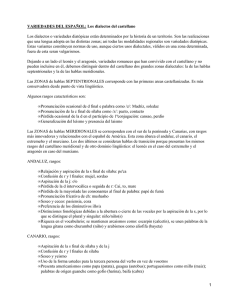
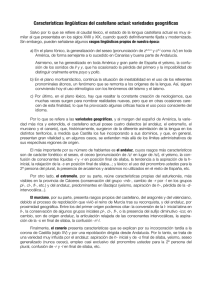
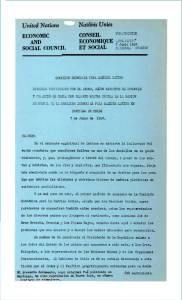
![Fonemas [θ] y [s] . La articulación en el seseo.](http://s2.studylib.es/store/data/006044660_1-f751e4037e9c451f3234ca097d3417d4-300x300.png)
